Day 2 of a three day long weekend of tours today. The thunderstorms overnight had passed through but the associated weather front was slow to clear this morning, resulting in a cloudy and cool start. However, it brightened up nicely in the afternoon and was sunny and warm by the end of the day.
Given the weather, we decided to start at Cley today. A Black-winged Stilt had been reported here first thing, so we went out to see if we could see it. We walked out to the hides and found a few people in there who pointed it straight out to us.
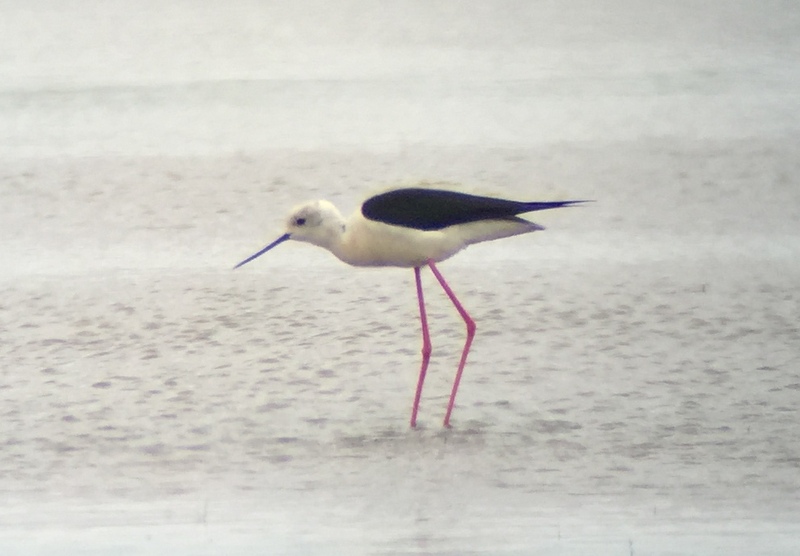 Black-winged Stilt – still a rare visitor to North Norfolk
Black-winged Stilt – still a rare visitor to North Norfolk
Black-winged Stilts were formerly a mainly Mediterranean species, but have spread north in recent years and are occurring more regularly in the UK. Birds have stayed to breed in the past and, after a significant influx of Black-winged Stilts into the UK earlier in the year, there are some attempting to breed this year. Over the longer term, with a warming climate, it is a species which might be expected to colonise here. As well as pairs which may breed, there are some wandering lone birds here this year and the Cley Black-winged Stilt was one of those. A very nice bird to see here and very distinctive with its long pink legs and black wings.
While we were in the hides, we had a scan of the scrapes. On Simmond’s Scrape, there were a few other waders – Avocets, Redshanks and a lone Dunlin with summer black belly patch. There were several Little Ringed Plovers out on the islands and a pair were displaying, the male flying round after the female with exaggerated wingbeats. When they landed again, the male stood in front of the female with his white chest pushed out – she didn’t seem particularly impressed and ran away!
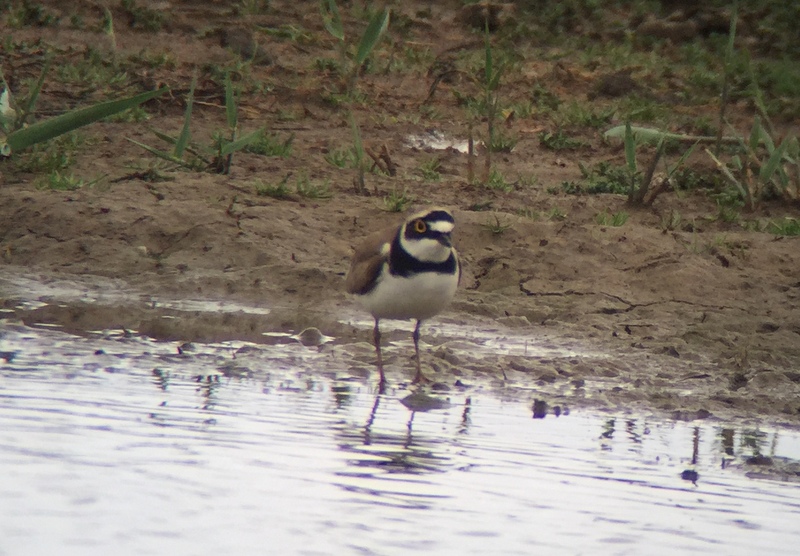 Little Ringed Plover – there were several on Simmond’s Scrape today
Little Ringed Plover – there were several on Simmond’s Scrape today
The big creche of Shelducklings was still here, but split into two groups today. The smaller ones were huddled in the grass with the female Shelduck, whereas the eight larger ducklings were feeding feverishly, swimming round in circles in the water. There were lots of Gadwall too, all drakes and all sat around on one of the islands sleeping, presumably having largely finished their limited parenting role already.
Looking over on Pat’s Pool, there were several Avocets nesting on the islands and a couple of small chicks running around, as usual largely ignored by their parents. Is it any wonder they are so vulnerable to predation! A Marsh Harrier was quartering over the reeds beyond.
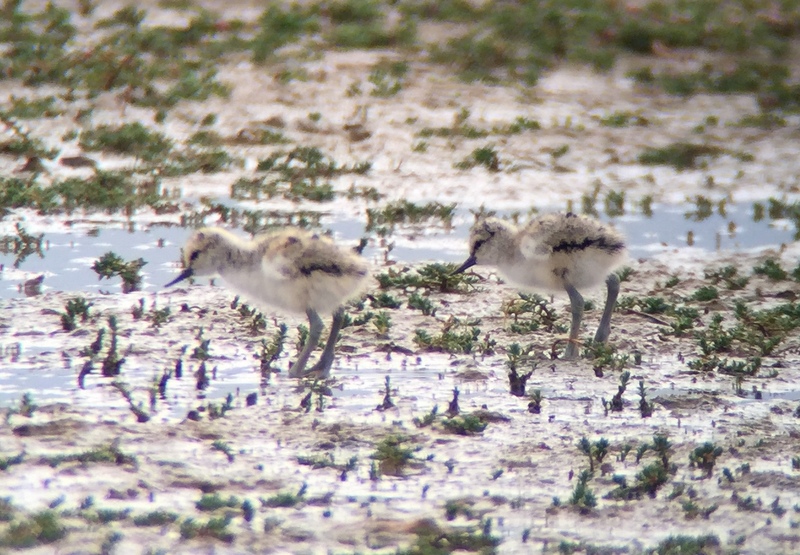 Avocet chicks – these two were running around unattended on Pat’s Pool
Avocet chicks – these two were running around unattended on Pat’s Pool
We made our way back to the visitor centre and then round to the East Bank next. A Sedge Warbler was singing from the thin line of reeds along the ditch on the east side of the path, giving us a great chance to get a proper look at it. There were lots of Sedge Warblers singing and displaying along the East Bank this morning, which was nice to hear. The Reed Warblers in contrast have gone rather quiet though we saw odd ones flicking around on the edge of the reeds.
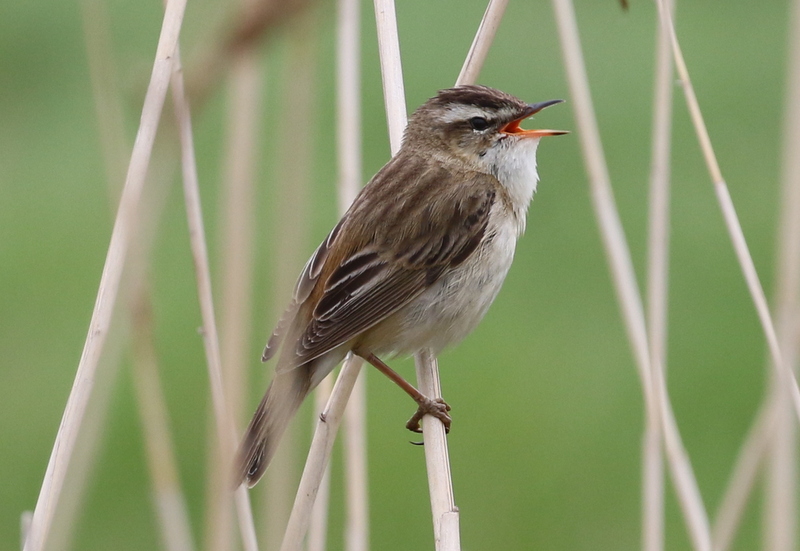 Sedge Warbler – showing very well along the East Bank
Sedge Warbler – showing very well along the East Bank
As we walked out along the bank, we scanned the grazing marshes around the Serpentine and Pope’s Pool. There were quite a few Lapwings and Redshanks out here as usual, both of which breed here. A Common Snipe along the edge of the Serpentine was more of a surprise. They used to breed here but sadly not any more and now are mostly seen in winter. This is the first we have seen here for several weeks now.
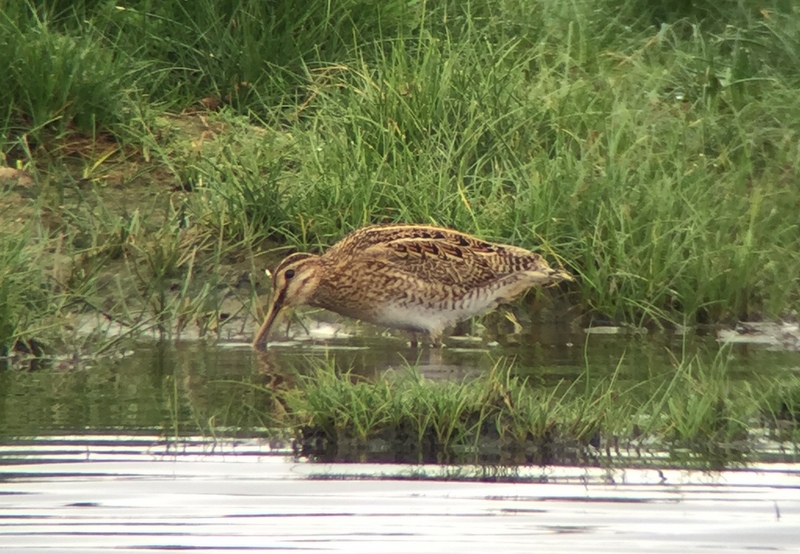 Common Snipe – feeding on the edge of the Serpentine
Common Snipe – feeding on the edge of the Serpentine
There were the usual ducks and geese on the grazing marshes here – Gadwall, Mallard, Shoveler and Greylag Goose. Most of the wintering species have long since departed, but there are still a few birds lingering here. We found two drake Wigeon here as usual this morning, but there seemed to be more Teal today, including a couple of pairs.
It was quite windy today, so not an ideal day for looking for Bearded Tits. We heard one or two calling briefly from out in the reedbed on the walk out but couldn’t see them – they were presumably keeping tucked well down in the reeds. When we heard another call, we turned to look hoping to catch a glimpse of one zooming past over the tops of the reeds and were pleasantly surprised to see a male Bearded Tit flying straight towards us which dropped down on the near edge of reeds.
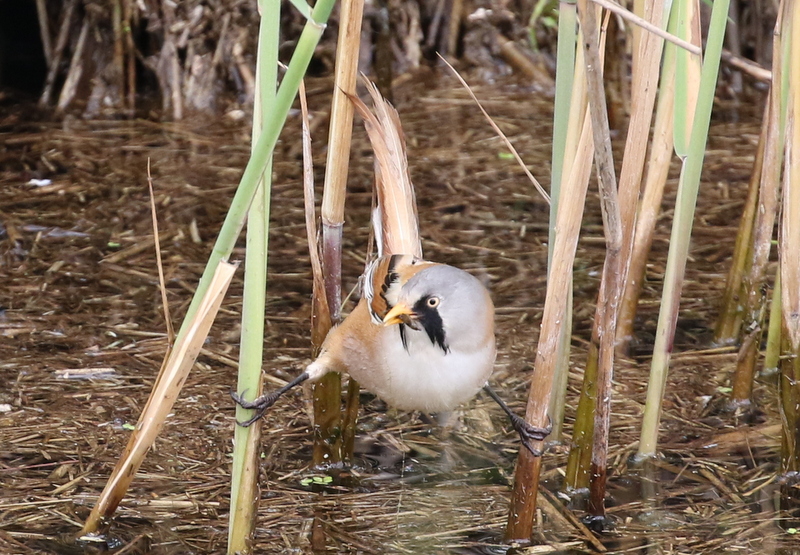 Bearded Tit – this male was collecting food along the edge of the reeds
Bearded Tit – this male was collecting food along the edge of the reeds
The Bearded Tit spent several minutes feeding along the edge of the reeds in front of us, clambering around through the reed stems just above the surface of the ditch. It was collecting food, and kept stopping to look down into the water or to pick around in the reed debris on the bank beyond. We got great views of it as it did so.
When the Bearded Tit finally disappeared back into the reeds, we continued along the bank to Arnold’s Marsh. There were not as many birds on here as there have been recently, but we still managed to find a single Bar-tailed Godwit, a lone Dunlin and one Ringed Plover hiding in the saltmarsh at the back. Otherwise it was just the usual Avocets and Redshanks on here today. A Meadow Pipit was singing and song flighting, fluttering up and parachuting down, to a fencepost nearby.
We made our way out to have a look at the sea. It can be rather quiet at this time of the year, but there were a few Sandwich Terns flying past offshore, which was a new bird for the weekend’s list. A Little Tern flew east but was gone before everyone could get onto it. Thankfully, a short while later four Little Terns flew back west overhead, calling noisily. A pair of adult Mediterranean Gulls flew over behind us, helpfully also calling which alerted us to their presence. We could see their distinctive white wing tips as they passed.
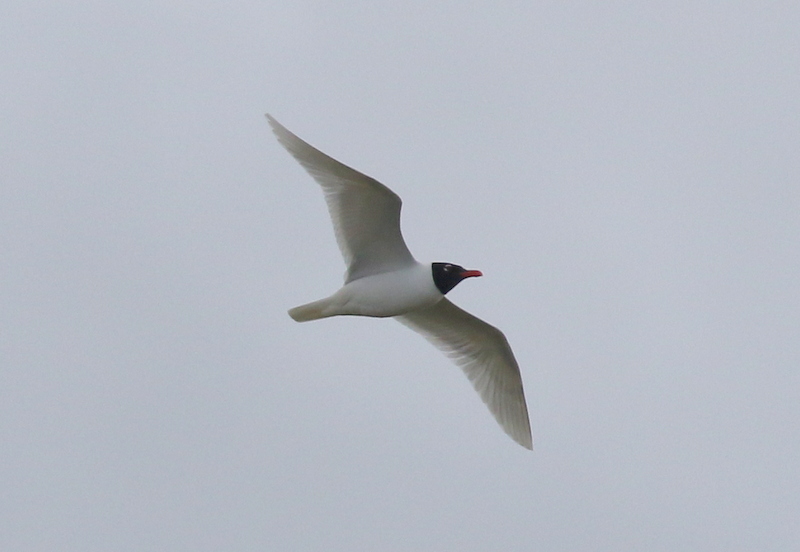 Mediterranean Gull – one of a pair of adult which flew past us
Mediterranean Gull – one of a pair of adult which flew past us
Scanning out over the sea, we picked up a line of Common Scoter flying west, fourteen of them flying low over the sea, followed shortly after by another four. One of the group then spotted a distant Guillemot on the sea, which we just all managed to see before it flew off. Three Gannets flew east.
The weather forecast had been for it to brighten up this morning, but the cloud was only now starting to break up as we walked back. We decided to stop for lunch back at the visitor centre before heading up onto the Heath for the afternoon.
As soon as we got out of the car up on the Heath, we could hear Willow Warblers and Common Whitethroats singing. As we walked up the path, a Yellowhammer was singing too, perched in the top of a birch tree. There were plenty of Linnets in the gorse as we walked round, in small family parties now, twittering noisily as they flew off.
 Linnet – still a relatively common bird up in the Heath
Linnet – still a relatively common bird up in the Heath
There was no sign of any Dartford Warblers today at the first place we checked – they can be very elusive, keeping hidden in the heather and gorse – so we carried on round the Heath to try another spot. We stopped to look at a group of Small Eggar Moth caterpillars in their silk ‘tent’ in the bushes and while we were standing there a Garden Warbler started alarm calling nearby. It flew up into a small oak tree where we could just see it flitting around in the leaves before it flew off deeper into the trees.
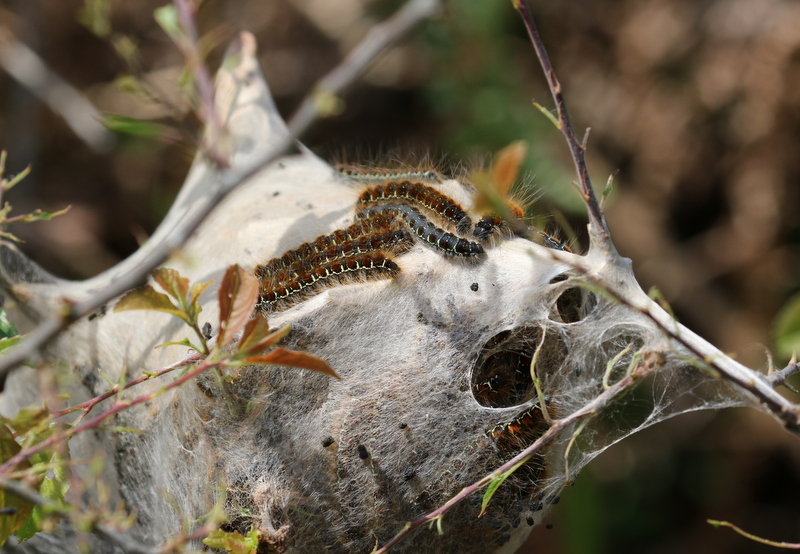 Small Eggar Moth caterpillars – in their ‘tent’
Small Eggar Moth caterpillars – in their ‘tent’
As we walked down along a wide path, a Woodlark flew up from across the Heath and started to sing, circling around above us. We could hear its rather mournful song, before it fluttered away from us out of earshot, still singing, and dropped back down to the ground some distance away. We saw it twice today – a little later, it flew up again and came back over us singing, before dropping back down over where it had first come up from. With the male Woodlark flying round and singing on his own again, perhaps this pair of Woodlarks are now incubating their second brood already.
While we were watching the Woodlark singing overhead, we could hear the scratchy song of a Dartford Warbler in the distance too, so made our way quickly round to where it appeared to be coming from. It was all quiet when we got there, but we stood and listened for a while. A pair of Stonechats kept us entertained, perching up on the top of the gorse calling and dropping down to the ground to look for food.
Suddenly a Dartford Warbler started singing and we turned to see the male on the top of a gorse bush just a couple of metres away from us. It had probably been feeding quietly down in the gorse all the time we had been standing there! We had a great view of him. After a couple of seconds he dropped back into the vegetation, but a minute or so later he flew up and started songflighting, hovering in the air and singing.
 Dartford Warbler – the male suddenly appeared right next to us, singing
Dartford Warbler – the male suddenly appeared right next to us, singing
The male Dartford Warbler dropped down out of view further along the path, so we walked quietly round after him. Suddenly a bird appeared out on the edge of the path, but it was shorter tailed than an adult Dartford Warbler and rather duller coloured. It was a recently fledged juvenile, out of the nest now, but with its tail not yet fully grown. Once the young are big enough, the adults lead them from the nest and feed them in the heather and gorse, moving round their territory.
The juvenile Dartford Warbler flew up into a small birch tree by the path and we stood back to watch from a discrete distance. It was mostly hidden by the leaves, but we could see it was being fed by an adult and when that bird hopped up onto a bush nearby, it was the female Dartford Warbler, not so richly coloured below as the male.
We stood and watched the Dartford Warblers quietly for some time as the female kept returning to feed the juveniles, which were now well hidden deep in the heather. There was no sign of the male for quite a while, but then suddenly he flew in again, and started singing. We listened to him for a few minutes, but as he moved away across the Heath we decided it was then time for us to move on too.
The afternoon was already getting on, but we had a quick look round the rest of the Heath. There is a pair of Turtle Doves here, and we checked out a couple of favoured spots, but we couldn’t hear them today. Now that the sun had come out, there was a bit of raptor activity – several Buzzards circled up over the ridge and we came across a Kestrel flying round between the trees. There were butterflies too – the highlight being a Green Hairstreak fluttering around a gorse bush. Then we decided to head back back to the car – we all needed a break and a chance to get something to eat before the evening’s activities began.
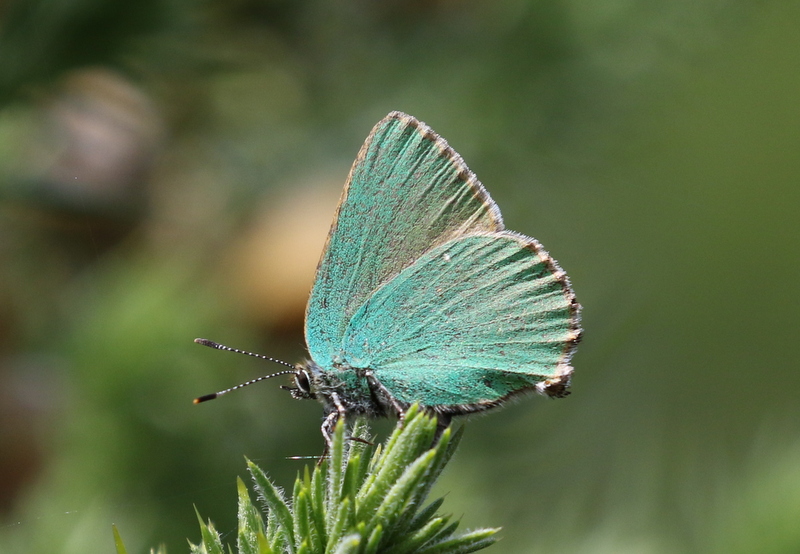 Green Hairstreak – the butterfly highlight on the Heath this afternoon
Green Hairstreak – the butterfly highlight on the Heath this afternoon
After a break, we met up again later, in the early evening. We were heading out to look for Nightjars later, but we thought we would see if we could find any owls first. We swung round via some old farm buildings, a good site for Little Owl, but there was no sign of any out in the early evening sunshine. Perhaps it was still a bit early? A couple of Brown Hares chased each other round between the buildings, but quickly lost interest. A pair of Red-legged Partridges were perched up on roof enjoying the sun.
We had other things we wanted to do tonight, so we moved quickly on. We had more luck at the second site we stopped at. We got out of the car and as we were walking down along the path, we saw our first Barn Owl out hunting in the distance. A second Barn Owl appeared too, possibly a pair, although this is a good area for them and there can be several birds here. We watched the birds hunting out over the grass. They were rather distant at first, but then one flew in towards us and landed on a post briefly – we just had time for everyone to get a good look at it in the scope before it was off hunting again.
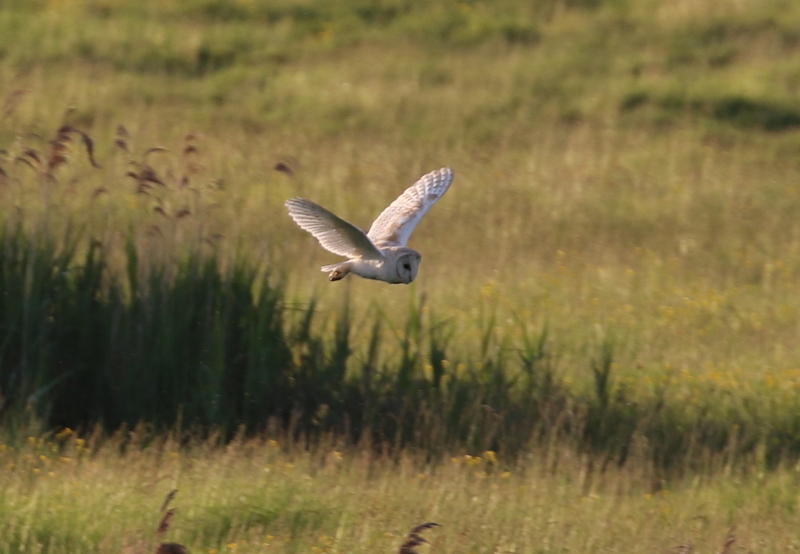 Barn Owl – out hunting in the early evening sunshine
Barn Owl – out hunting in the early evening sunshine
Walking on a bit further down the path, we could still see one of the Barn Owls out hunting along the bank some way ahead of us. It dropped down into the grass a couple of times, but came up empty taloned. Finally it caught something, probably a vole. It flew back towards us carrying it in its talons and was just about to fly past us when a Kestrel suddenly appeared from nowhere and swooped at it. The two of them tangled in a flurry of wings and the Kestrel made a grab for the vole, they looked locked together for a split second. They parted again and the Barn Owl dropped to the ground, with the Kestrel swooping at it from above.
The Kestrel backed off, and after a few seconds the Barn Owl flew up again with the vole in its bill now. But the Kestrel had not given up and set off after it again. We lost sight of the two of them behind some buildings, but a few seconds later, the Barn Owl reappeared with no sign of its prey. It sat on a post looking slightly lost – all that effort for nothing!
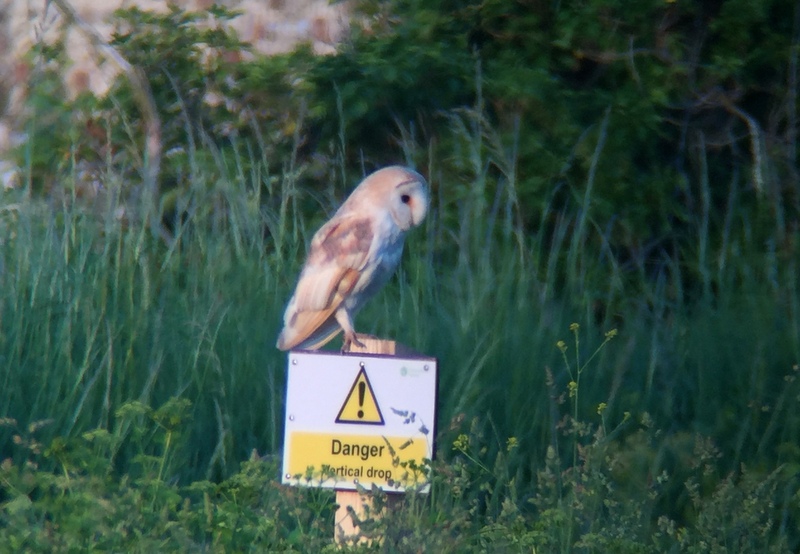 Barn Owl – perched on a post after apparently losing its prey to a Kestrel
Barn Owl – perched on a post after apparently losing its prey to a Kestrel
It was getting time to go looking for Nightjars now, so we made our way up to the heath. It was quiet at first as we walked out. We flushed a Roe Deer from beside the path, which ran off into the trees. A squeaky call, rather like a gate which needs oiling, alerted us to the first roding Woodcock of the evening, flying over the tops of the trees. We stopped to listen for more Woodcock but we heard a Nightjar instead, just a quick burst of churring, before it went quiet. It was a bit earlier than normal so we moved on and got ourselves into position.
While we were standing there, another two Woodcock flew out of the trees calling and away overhead. It was a lovely evening now, with a bright half moon in the sky and Jupiter visible close by. After that early churr, the Nightjars were then slow to get started properly this evening. Eventually we heard one call, and then some more quiet churring.
Then finally the Nightjars got going properly. We stood and listened to them churring for a while, at least three males, possibly four in earshot from where we were standing. We were waiting for one male in particular, but it sounded like he had gone off in the wrong direction across the heath and it began to seem like wouldn’t be coming in to his favourite churring post, which we could see in front of us.
Eventually, we decided to walk down the path to see if we could find where it had gone. Suddenly we heard a burst of wing clapping out over the gorse and the Nightjar flew in low right towards us. It swooped up onto its favourite branch but unfortunately this was just at the moment when we were walking past the tree. We were too close – it saw us and flew again, across and up into the next tree over. This one has more leaves so the Nightjar is harder to see, but we eventually found him perched. We got it in the scope, and could see it silhouetted against the fading light behind, churring.
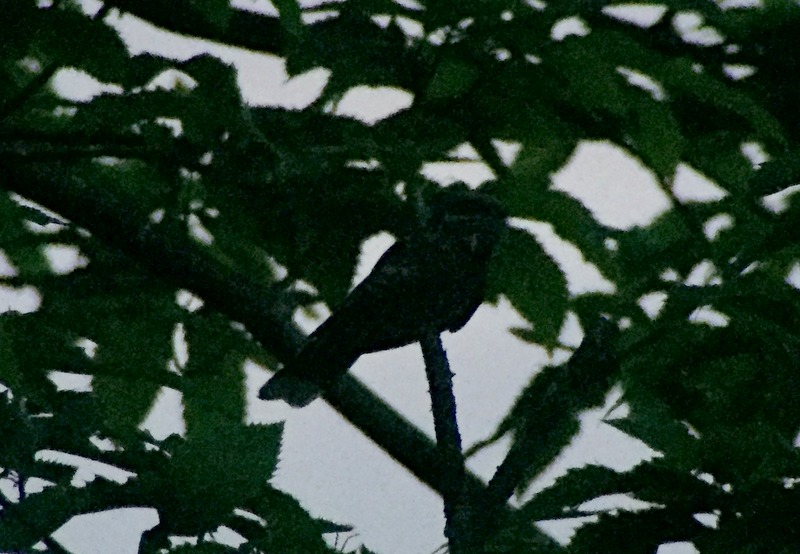 Nightjar – silhouetted against the fading light in a leafy tree
Nightjar – silhouetted against the fading light in a leafy tree
We stood and listened to the Nightjar for a while. Then it was off again – it swooped down across path the path and away low over the heath. It was starting to get too dark to see them clearly now, so we we started to make our way back. Two more Nightjars were churring from the trees as we walked back, slipping away into the night as we approached. There is no better way to spend an early summer’s evening than up on the heath listening to the amazing churring of Nightjars.
















